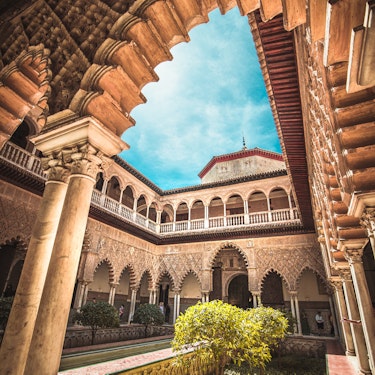More about: Seville in 5 Day: a guidebook for getting the most out of your visit
When you organize a trip, sometimes it is complicated to plan each day, especially with the large number of plans to see and do in a city like Seville. The good thing is that since you will be in the city for five days, you will have enough time to see everything in detail, especially if you follow my advice and the daily tours I have prepared.
Day 1: See the most important and popular places in Seville
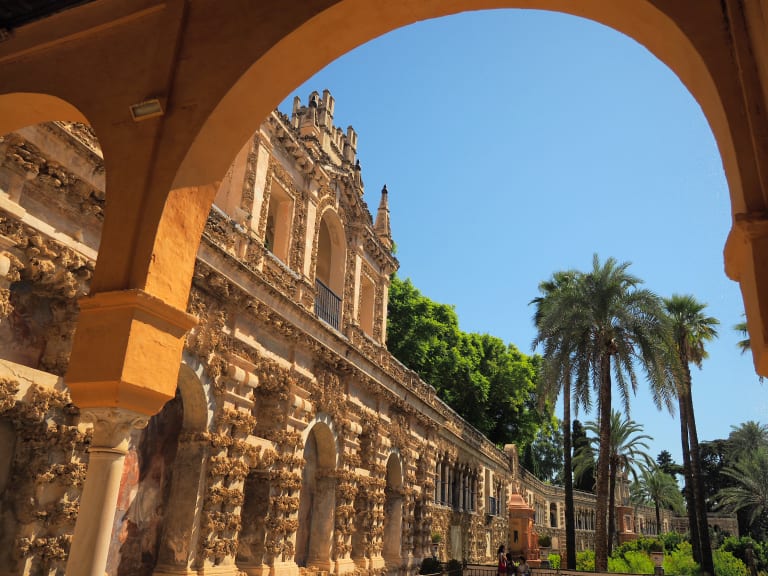
Surely you are full of energy and eager to start your visit to Seville, so for this first day it is best that you cross off the list those places that, because of their importance, you have to visit yes or yes, such as the Alcazar or the Cathedral. Shall we start?
Spend the morning touring the Real Alcazar of Seville
There are few better places to start your trip than the Real Alcázar of Seville. This palace complex, which is located in the historic center of the city (specifically you enter through the Plaza del Triunfo), is one of its emblems.
You can book your ticket for the Alcazar, from $23, but you can also book a guided tour of the Alcazar, the Cathedral and the Giralda of Seville. Keep this in mind because these two places are also part of the itinerary of your first day.
Visiting the Alcázar of Seville is to enter a fairytale palace, where different architectural styles are mixed together. My advice is to visit it calmly, taking time to walk through its gardens, which may ring a bell for having been the scene of an episode of Game of Thrones.
Stroll through the Murillo Gardens before lunch
Leaving the Alcazar you will find the Murillo Gardens and its gazebos, decorated with ceramics, bricks, fountains and lots of vegetation.
Although they are now a public space, they were formerly part of the palaces, hence their proximity. In fact, just at the entrance to the gardens you can see part of the old Alcazar Walls.
In addition to orange trees, magnolias and other tree species, in these gardens you will find sculptures representing illustrious citizens of Seville and Spain, such as the Catholic Monarchs or the literary character Don Juan Tenorio.
Take a tapas tour of the Santa Cruz neighborhood
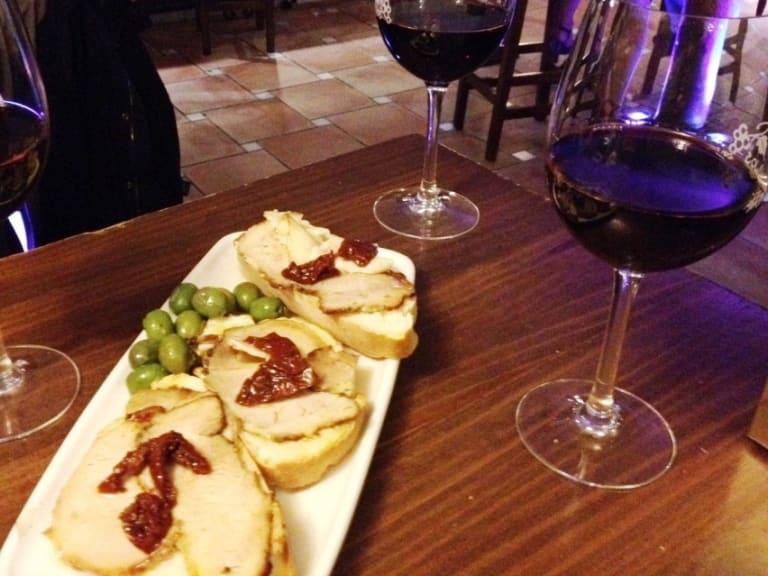
After a morning spent at the Alcazar and its gardens, you will surely feel like stopping for a bite to eat. The good thing is that you are in one of the best neighborhoods in Seville: Santa Cruz.
As sometimes choosing just one bar is complicated, I advise you to book a tapas and flamenco tour in Seville, which includes a complete tour of the best bars in the area, where you will taste typical tapas accompanied by a specialized guide.
They say that one of the best ways to get to know a city and a culture is through the stomach, so why not check it out? Then you can take a stroll through the Santa Cruz neighborhood of Seville.
Enter the Cathedral of Seville and climb the Giralda
After lunch, it's time to resume your itinerary and book your entrance to the Cathedral and Giralda, which are also located in the Santa Cruz neighborhood. The Cathedral is the largest Gothic temple in the world and the Giralda is the ancient Almohad minaret that later became a Christian bell tower.
The exterior portico of the Cathedral of Seville is one of the elements that will catch your attention, although the great treasures are inside (if you don't believe me, wait until you see the Patio de los Naranjos or the sacristies).
Of course, the visit is completed by climbing to the top of the Giralda. Don't think that there are many steps, because what you will find is a long ramp that the ancient sultan decided to install to be able to ascend with his horse.
Finish the day visiting the Hospital de los Venerables
In the 17th century, the idea was to build a place where elderly priests, impoverished by the plague, could retire. Thus was born the Hospital de los Venerables, although today it has become a museum which houses one of the best collections of the painter Diego Velázquez and other of his contemporaries (such as Murillo or Zurbarán).
I highly recommend you go; it is about 5 minutes from the Cathedral and the entrance fee is only about 5 €.
In addition to the artistic center, the Hospital de los Venerables also has a beautiful church in the purest Sevillian-baroque style, and a central courtyard where you can sit and rest for a while after a day visiting the city.
Day 2: Discover the secrets and history of Seville

For the second day I propose you to discover some of the secrets of Seville, both buildings that are not always visited but are spectacular, as well as places that keep a lot of history.
Among so much information and facts, there will also be time to be outdoors and enjoy the city from the heights.
Immerse yourself in history through the Archive of the Indies
Seville is a city that holds a lot of history, but if I had to tell you one place where this is most evident, it is the Archivo de Indias.
Admission is free and it is in the center, near the Maria Luisa Park, so it is a good place to start the second day in Seville. It houses documents of great value, such as the contract that Christopher Columbus signed with the Catholic Monarchs, as well as many other maps, drawings and diaries of those first voyages to America.
Its original use was as a Lonja, that is, as a space for traders to make their deals and exchanges. However, over time it became the Casa de Contratación and then, in 1785, the documentation center for everything related to the Spanish presence in America.
Visit inside and out of the Royal Tobacco Factory
To start the second day in Seville, I thought nothing like discovering one of those hidden treasures of the city: the Royal Tobacco Factory.
Perhaps this stone building, which is located next to the Alcazar and is currently the rectorate of the University, does not particularly catch your attention, but you have to know that it was the first tobacco headquarters established in Europe, back in the eighteenth century.
Its design is one of the best representations we have of the architecture of the Ancient Regime. If you are surprised by how big it is, it is not surprising: the building has dimensions only surpassed by the palace of El Escorial. You can visit it inside for free, especially at times when there are no university classes (weekends and midday).
Sit on the big bench in Plaza de España

You may be in Seville, but when you arrive at Plaza de España you will feel that all the provinces of the country welcome you. How? Through the big bench that crosses this square, which is only ten minutes away from the Real Fábrica de Tabacos (Royal Tobacco Factory).
Through a detailed and beautiful tile work, the different cultures of the national territory are represented on the bench.
Beyond this, the Plaza de España is a must-see if you are in Seville. In addition to the institutional buildings there, what stands out the most are its two towers, which can be seen from several points of the city. I advise you to book a tour of the Plaza España in which you will discover all the secrets of this emblematic place and also take a walk through the covered gallery that connects the two towers.
Buy a snack at the stalls in María Luisa Park
Turning your back to the towers of the Plaza de España, you will come across the Parque de María Luisa, your next destination.
In addition to strolling along its paths and among its plants, fountains and statues, I recommend you to go to one of the food stalls and order something there, I'm sure hunger is getting the better of you! If you prefer to sit in a restaurant, you will also find a wide offer; the views are unbeatable, the truth.
Maria Luisa Park is one of the largest in the city and, being in the center, acts as a meeting point for Sevillians. It was designed in the purest English style, so eating or strolling there you will feel like a real aristocrat and if you want to know all its secrets be sure to book a tour of the park Maria Luisa.
Say goodbye to the day from the top of the Torre del Oro (Gold Tower)
To end the day, how about watching the sunset of Seville from the Torre del Oro? Going up costs about 3 € and is worth it at any time of day, but when the sun goes down I have to say that watching the city from 36 meters high is quite a spectacle.
Although it has now become one of the best viewpoints in Seville, in its beginnings the Torre del Oro had a defensive function, which is why it was built on the banks of the Guadalquivir.
Take a boat ride on the Guadalquivir River
When you are done, I recommend you to book a boat ride in Seville. Most of these cruises depart from the pier of the Torre del Oro, so you can take advantage of the fact that you are there to close the day with a nice tour of the waters of the Guadalquivir. They cost approximately 20 € and it is well worth it; you will see Seville from a different perspective.
The Guadalquivir is part of the culture of Seville. Its waters cross the city, dividing it in two, so sailing along them means that you will be able to see important buildings on both banks. In addition, you will have the explanations of a guide who will discover the secrets and the most local aspects of the city.
Day 3: Cross the Guadalquivir to Cartuja and Triana

Although until now you have always been on the left bank of the Guadalquivir, for the third day I propose you to cross the river and get to the right side, where you will find the modern Isla de la Cartuja and the traditional neighborhood of Triana.
Visit the more modern Seville of Isla de la Cartuja
Although the rest of the days have started in the center of Seville, in this third you will have to move (by bus with lines C1 or C2, because walking is more than half an hour from the center) to the Isla de la Cartuja, an enclosure built for the Universal Exposition of 92 and is now a Technology and Science Park with a wide range of leisure.
My advice is to spend part of the morning visiting the Alamillo Park, the largest in Seville and home to many species of plants and birds. Then continue your walk past the Caixa Forum, where you can enter to see some interesting exhibitions, and the Tower of Seville, where the Isla de la Cartuja ends and the Triana neighborhood begins. If you prefer, you can take the C3 bus again to get there.
Contemplate the rich simplicity of the Chapel of Carmen
Already in the Triana neighborhood you can make a first stop at the Capilla del Carmen. Don't let its small size fool you, there are few buildings more curious and beautiful than this one. Its design is the result of the work of an architect and a ceramist, hence the mix of colors and the use of brick as the main element.
Although you can simply see it from the outside, I recommend going inside (access is free) to see the artistic works created with tiles. The Capilla del Carmen is considered one of the entrances to the Triana neighborhood, so let its octagonal bell tower and dome welcome you.
Taste the best Andalusian dishes in the Triana market

After all morning walking, I'm sure that hunger is encouraging you to stop for a while, how about doing it in the Triana Market?
Located on the first floor of the old court of the Inquisition (the Castle of San Jorge), this market is a good place to go for tapas, as in addition to stalls selling fresh produce there are also small taverns. Another option if you want to taste the best dishes is to book a tapas tour of Triana.
Also known as the Plaza de Abastos, the Triana Market is very popular for its culinary value but also historical, as the remains of the castle can be visited. This is a good (and free) plan to do after tapas, don't you think?
Visit and get to know the Triana neighborhood
In the Triana neighborhood of Seville there is much to see, so I suggest you spend the afternoon to walk around and let yourself be invaded by its art, culture and atmosphere. In addition to the Capilla del Carmen and the Market, there are other places that I want to recommend you and that you can easily reach by walking around the neighborhood.
Be sure to see the Plaza del Altozano, the building of the Murillo Pharmacy and Betis Street, one of the most important of Triana for having stunning views of Seville from across the Guadalquivir. And before you finish your walk, enter one of the patios of neighbors so typical of Triana, always decorated with plants.
One option to visit it comfortably is to book a private tour of Seville.
Get excited in a flamenco show
The Triana neighborhood has been the birthplace of many singers and dancers, so it is one of the best areas to enjoy a flamenco show in Seville. It is an experience not to be missed if you are in Seville; the rhythms of the dance, the heels and the guitar are mixed in a unique live cultural show.
If you want to discover the authentic Seville, you have to book a flamenco show in Triana. As these venues are all about maintaining the intimacy and excitement of this art form, seating is limited and it is best to book early.
Day 4: A tour of the center and the banks of the Guadalquivir River
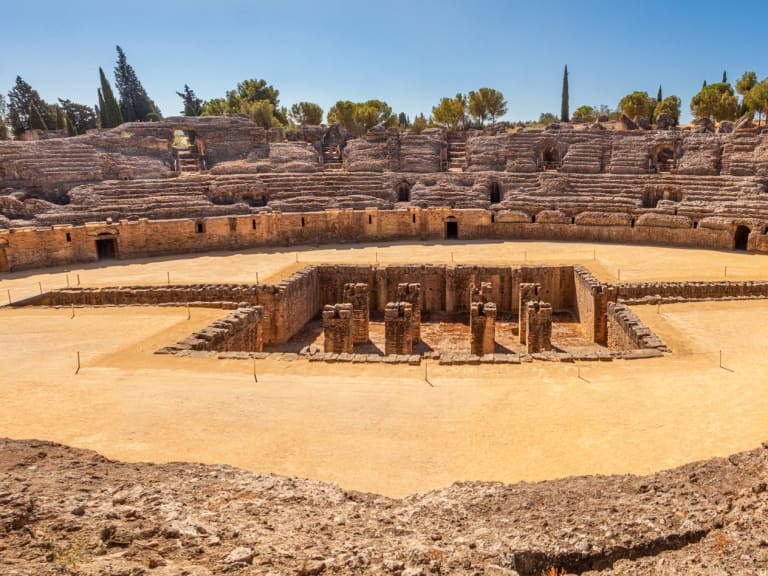
Although the trip is coming to an end, there are still several places to visit in Seville. For this reason the fourth day has as protagonists such emblematic buildings as the Maestranza or the Reales Atarazanas, as well as the banks of the Guadalquivir.
Spend the morning visiting Italica, the Roman ruins of Seville
Have you heard about the Roman ruins in Seville? Now that you know they exist, I will explain how to get from Seville to Italica, the place where they are located. It is a very interesting visit, since you will know what was one of the great Roman cities. The most advisable way is to book an excursion to Italica, since from 41 € you have included direct travel and a visit at the hands of a specialized guide.
If you prefer to go on your own, you will have to take one of the two bus lines (the M-170A and M-170B) that connect the center of Seville (Plaza de Armas) with Italica. The price is about 2 € each way. Access to the ruins is free for EU citizens (for non-EU citizens, you will have to pay about 2 €).
Once in Italica, get ready to enter the Roman Empire. You will be able to visit the ancient amphitheater and the houses where the inhabitants lived; everything is quite well preserved, although I recommend you also enter the museum to see up close other objects that were used then, and other archaeological treasures.
Discover the function of the Reales Atarazanas
Don't know what the Reales Atarazanas of Seville are? When you come back from Italica, I recommend you to go inside (it's free). Its large size will give you a clue about the function of this place; this is where ships were built, especially at the time when they flocked to America.
This large factory is located very close to the Torre del Oro and only one meter above the water level of the Guadalquivir, which facilitated the departure of the ships.
The building, like many others in Seville, combines Gothic and Mudejar styles. What is most striking is its immense interior in which different naves are connected. Fishermen, sailors, artillerymen, etc. worked here for many years.
Buy antiques and stroll through the Plaza del Cabildo

Just a three minute walk from the Reales Atarazanas is the Plaza del Cabildo. This place always has visitors, but if you happen to go on a Sunday it will be more crowded than usual, as this is when the numismatics and collectors market of Seville is held.
In any case, whatever day you go, it is a square where there have always been many antique stores, so if you are looking for an original gift to take from Seville, you are in the right place.
The structure of the square is semicircular, so the building in it is also semicircular. It has three floors (all of them curved) and is famous for its balconies, painted and decorated by the painter José Palomar. Without a doubt, it is a good place to take a photo and walk around. And from there you can book a tour through the Jewish quarter.
Sit on the banks of the Guadalquivir and have a bite to eat
Although in the area you are in you are sure to find many restaurants where you can sit down to eat, I recommend you take something to go and go to the banks of the Guadalquivir. All around the Paseo de Cristóbal Colón area there are benches from which you can see the river (and the Triana neighborhood on the other side) while you fill your stomach.
When you finish, take the opportunity to take a stroll while you head to your next destination: the Plaza de la Maestranza.
Get close to the Plaza de la Maestranza
The Plaza de la Maestranza is the oldest bullring of its kind and, even if you don't plan to attend a bullfight, you may be interested in going to see it. In fact, it is one of the most visited places in Seville. Perhaps seeing it from the outside is enough, although you can access the interior for about 10 €.
The architectural element that most often catches the attention of everyone who enters is the interior facade (the Palco del Príncipe), which is topped by a half vault topped with tiles.
Contemplate Seville illuminated from the Muelle de la Sal (Salt Dock)
There are few images more beautiful than seeing the Triana neighborhood illuminated from the Muelle de la Sal. Its name, as you can imagine, is due to the fact that it was the place where salt was unloaded.
Today it is like a balcony from which to observe the other side of the river. If you think the picture is beautiful, imagine how it would be to extend it through a boat ride through Seville at nightfall.
If you travel to Seville in summer, you will see this place more crowded than ever, as there are many people who come to enjoy the night breeze of the Guadalquivir after a hot day.
Day 5: Finish the trip in the noblest Seville
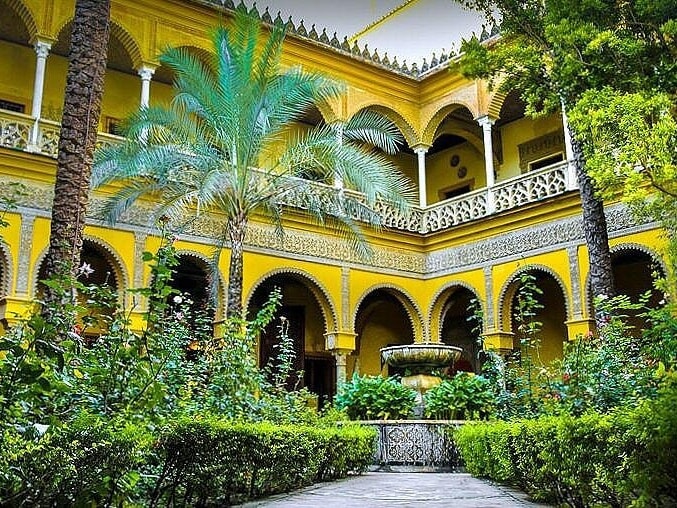
The trip is coming to an end, but before leaving Seville you might like to visit the richest part of the city, where the houses of old noble families mingle with neighborhoods full of modern places.
Get to know the Sevillian treasure in the Basilica of the Macarena
Start the last day with a visit to the Basilica de la Macarena, home to one of the most beloved treasures for all Sevillians: the Virgin of Hope.
It is located in the neighborhood of San Gil, opposite the Parliament of Andalusia, and you can access the interior for free, something I recommend especially to see the chapels. However, if you want to enter the museum, you will have to pay about 5 €.
Architecturally the basilica has only one nave and consists of a single floor. Its interior was decorated with marble of various colors and baroque elements, so expect to see a lot of ornamentation.
Enter the aristocratic Palacio de las Dueñas
Although many, many years ago where the Palacio de Las Dueñas now stands there was a monastery (from which it also took its name), this place has always been the residence of the most noble families of Seville. Since the seventeenth century it has been the residence of the House of Alba.
You can see that its historical value is very high, but if you book your ticket to the Palacio de las Dueñas you can see a lot of art. Taking San Luis street from the Basilica de la Macarena, you can get there in less than 15 minutes.
Beyond the private rooms, ballrooms and courtyards that can be visited, I recommend going to the Palacio de las Dueñas because it acts as a great museum of the works of painters like Sorolla, luxurious tapestries and other archaeological remains.
Take a break to try some of Seville's most innovative tapas
As soon as you leave the Palacio de las Dueñas you will be in the Encarnación-Regina neighborhood, which has a lot of history and also a lot of gastronomy, so I recommend you stop at a restaurant in the area, which have innovative proposals, or book a tapas and flamenco tour of Seville.
If you like to try new things, here you will be spoiled for choice. What a few years ago was a somewhat decadent neighborhood, now looks renewed and modern, full of places offering delicatessen dishes and reinventing traditional tapas.
Take a panoramic tour of the Seville Mushrooms
In the middle of the Plaza de la Encarnación are the famous Setas de Sevilla. I know the name is strange, but when you get to this modern monument you will understand that its shape is reminiscent of that food. The Setas are actually a structural ensemble formed by a large pergola.
In addition to its design, they are known because from its walkways, which reach 26 meters, you can see the old town of Seville. The truth is that going to the Setas is a good plan to close the trip and say goodbye to the city.
Discover the Andalusian architecture of the Casa de Pilatos

Just ten minutes from the Setas de Sevilla is the Casa de Pilatos, another noble residence built in a very Andalusian style. This palace in particular housed the Dukes of Medinaceli since 1639, although it is known for being the beginning of the Sevillian Holy Week and for its colorful interior.
As you read, in the sixteenth century began to celebrate a Via Crucis (a way of prayer) that started from the Casa de Pilatos to the Sevillian neighborhood of Nervion. Over the years, this path evolved into what today are the processions of Holy Week. In the inner courtyard of the palace are exposed several Roman sculptures, so it is worth paying the entrance fee (approximately 10 €) to see them.
Finish your trip to Seville in the Plaza de El Salvador
I know you don't want the end to come, but I promise you that having dinner in the area of the Plaza del Salvador, in the Alfalfa neighborhood, you won't leave with a bad taste in your mouth. This square is less than 10 minutes from the Casa de Pilatos and is full of terraces overlooking the cathedral and the Giralda, which at that time will be illuminated. Say goodbye to them while you dine.
This area has been a meeting point for years and years. Its social character, which is now more evident as it is completely pedestrianized, dates back to the 17th century. Today it maintains that spirit and is one of the best neighborhoods to get to know the culture of Seville through its tapas and typical dishes.
How to move around Seville: is it necessary to take a transport pass?

As you may have noticed, there are many things to see and do in a city like Seville and it is very important to organize your trip carefully and not to waste time in displacements. If you have been looking for information about the best way to get around Seville you will already know that you can get to many places on foot.
However, you always have the bus to go to more distant places, either because they are not in the center (such as Isla de la Cartuja) or because they are not close to your hotel. Although there is a metro, there is only one line while there are fifty bus lines, so they allow you to go from one side of the city to the other. Think that, if you follow the itinerary I have proposed and your accommodation is centrally located, you will only need to take the bus occasionally, so it is better to buy a single ticket (about 1.50 €).
If the hotel where you are staying is in the outskirts, you may need to take public transport more frequently and it will be more profitable to buy a tourist card for the bus of Seville (for 1 day it is 5 € and for 3 days, 10 € approximately, plus a deposit of 1.5 €); the good thing is that the trips with them are unlimited. I hope you enjoy your trip to Seville and that my tips will help you to organize 5 days of art, culture and history.

